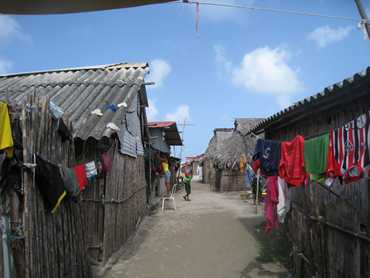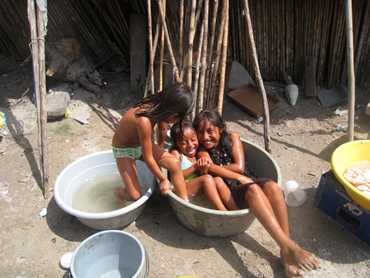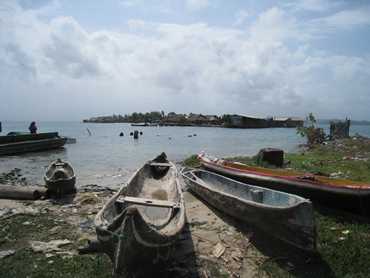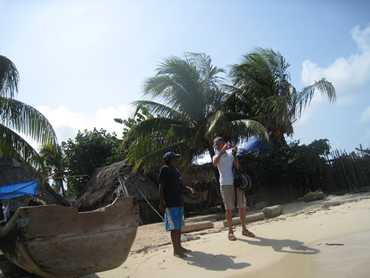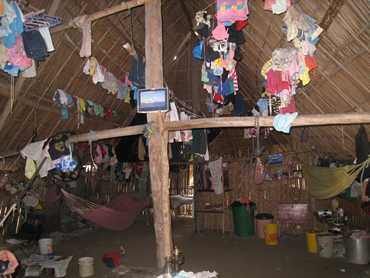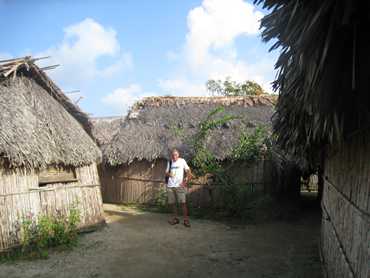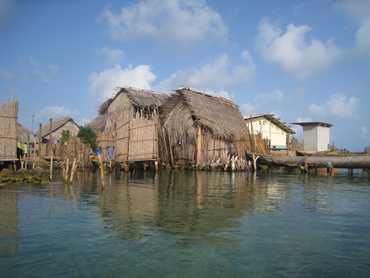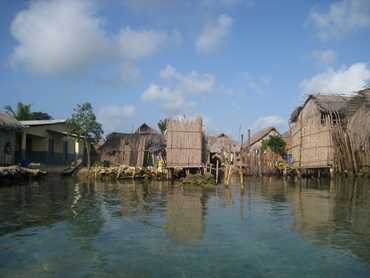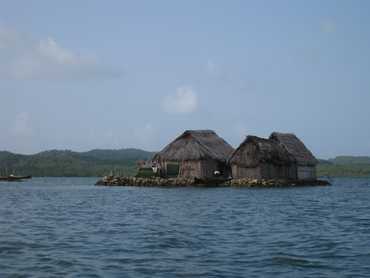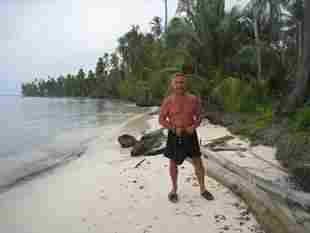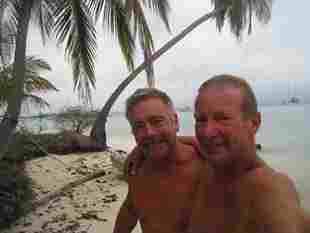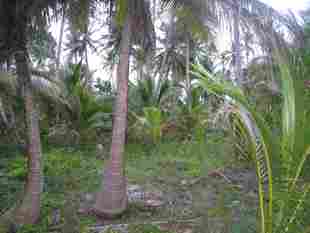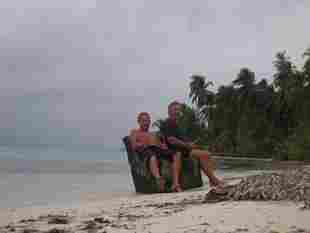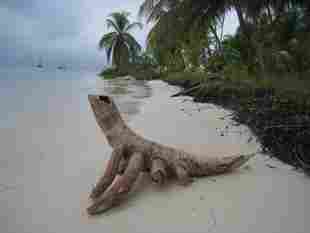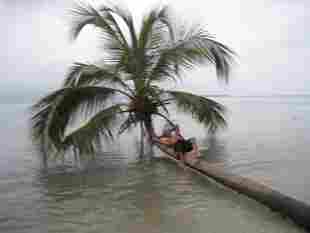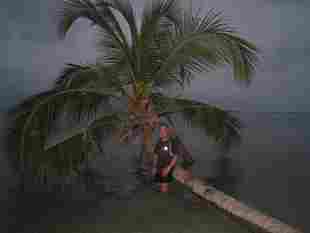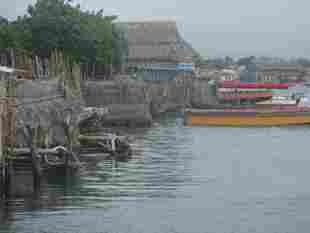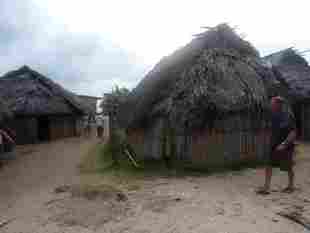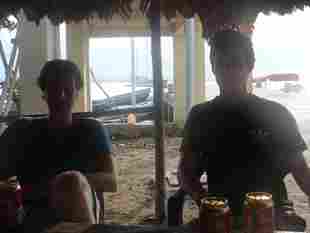Fai Tira in San Blas Green Island 09:28.77N 78:38.20W Thursday 4th February

|
Fai Tira
Blog Thursday 4th February Fai Tira in
San Blas Green Island 09:28.77N 78:38.20W Sadly we’re approaching the end of our encounter with
the San Blas Islands and the Kuna Indian race that cling to the surface of
hundreds of, sometimes tiny, outcrops peppering the Gulf of San Blas. They run
for about a 130 miles of coast line just off the Panamanian main land.
It’s been a pleasure, education and privileged to be able to wander the
dirt passageways acting as streets while we squeezed ourselves through the
narrow gaps dividing the maze of cane and palm frond dwellings.
We’d been welcomed by a proud race fiercely protective
of its heritage and eager to demonstrate its, largely undiluted, culture at
every opportunity. Their friendliness and honesty has been refreshing and it
seems to remain intact in spite of mounting pressure from a demanding tourist
industry, on which they are becoming increasingly dependant. A result of this
is an inevitable wear and tear was on the largest of the Carti islands,
Sugtupu. It was just starting to show signs that indicated a bit of fraying at
the edges. However, even this couldn’t detract from our visit. The tour
in, the company of our self appointed guide John, was friendly and fun: even
though tinged with a hint of enterprise that, at times, seemed to verge on the
edge of commercialism.
The journey the following day was about 5 miles, our
destination the small and picturesque island known as Mormake Tupu. In the
Chibcha language (No, not Kunaneese), it means “shirt makers” Our source of research, for these visits is limited to the
sometimes sparse information given in the pilot books. However we were able to
glean enough knowledge to make our visit sound interesting. Phrases like
“very traditional community” and “high quality crafts”
always have the effect of pushing the right buttons for me, and in the event, I
think, neither of us were disappointed. Our sail was a very relaxed affair, just what was needed
since we were still at the stages of the metaphorical first time back on the
bike, since the bashing we took on the crossing. So it was a languid passage
that took us in an Easterly direction with just the genoa gently tugging at the
sheets and easing us along at a comfortable 4-5 knots. The pilot book had also informed us that a firm congreso,
the body of elders in charge, encouraged visiting yachts to moor in the Caigar
mangroves, about a mile away. We didn’t feel inclined to go for that. So
it was with some apprehension, after negotiating the coral heads, that we
dropped anchor off the Southern tip a short distance from a concrete jetty. Already a small, curious, group had gathered, but before we
had a chance to launch the dinghy, we had visitors in the form of two
delightful women. They were both clothed in vividly colourful costumes, and
each of them displayed a delicately painted black vertical strip running up to
the bridge of their nose. They’d rowed out in one of the many wooden dug
outs that are everywhere and seem to be the standard mode of transport. The
purpose of the visit soon became obvious (as if we didn’t know). Out of
two plastic containers came a whole range of delightful molas (embroidered panels)
Half an hour of fun filled bartering later and the form of a brightly
coloured yellow fish adorned the dark wood work, above the seating in our
saloon.
Then it was the turn of Idelfonso Restrepo and another dug
out was parked alongside. He turned out to be a great guy and we invited him on
board for a beer. He was young, spoke understandable English and earned his
living as a tour guide. He wasn’t trying to make anything out of us. He
just wanted to talk, be friendly, show off his island and ensure that we respected
and had some understanding of the Kunar culture, much of which seemed to be
built on foundation of respect. He informed us that the Kunas’ had
their own flag, also saying that he would introduce us to the congreso chief .
Arrangements were made. We eventually ventured ashore about half an hour
later to be greeted by him and dozens of inquisitive children. We’d come
prepared with a rucksack full of pencils, braids and bangles. I’ve never
seen so many hands thrusting out in one go and we strode off to
Idelfonsos’ house looking, for all the world, like versions of the pied
piper. Our stay was terrific; we were given so much attention.
Introduced to families, we bought a flag, exchanged gifts with the chief,
sampled the local bread, drank beer and were then lucky enough to spectate at
the village dance practice and listen to the haunting sounds of the
accompanying pipes.
The next days’ sail, to Green Island, was brilliant, a
broad reach on a port tack, in bout 20 knots of wind, a calm sea, just the genoa
hoisted and making 6-7 knots. The 18 miles simply flew by. I’m sure
that the rain forest clad slopes of the nearby mountains would have looked
spectacular, if it wasn’t for the heavy mist that shrouded them. The
forests here are some of the few that are not only sustained, but indeed
thrive. Left to their own devises and with the Indians taking just what they
want for their own needs, they flourish. The approaches to Green Island were interesting. The genoa
refused to furl, the rope having tangled itself into a knot.
It had to be dropped, but was now in a strop and refused to come down,
we’d also noticed that the windex had also stopped working. By the time
we’d got our act together we were off course and the wrong side of a
reef. We could see where we needed to be, It was just getting
there!!
Pete was on the bow sprite hollering directions, while I
pointed it and watched the rapidly falling depth gauge. The bottom looked so
close, it felt like you could step off and paddle. With the gauge now reading well under 2 metres, we gave up,
backed up and then turned round, eventually finding another way in and joining
up, for the first time in 3 days, with a bunch of BWR boats. The rest of
the day was spent snorkelling and climbing the mast to inspect the windex
transmitter. We identified the problem. It was that one of the little cups had
become detached, preventing it from spinning. We also found a more serious
problem and one more difficult to resolve. The forestay foil had sheared at the
top. It wasn’t going to prevent its’ use, but it wont cure itself
and can’t be ignored. In the evening we just went to Jeremys’ for supper.
Actually that was wrong. No one can ever “ just go to Jeremys” The two J’s and Edith were, as usual, brilliant and
funny hosts. We both staggered back to our boat at 2am!!! The sail back to Porvenir the next day was another fantastic
one. A beam reach on a starboard tack, in about 25 knots of wind, under full sail,
moderate seas and making 7 Knots. Fantastic scenery and warm, if cloudy,
weather. What d’ya reckon??? Not bad eh!!!! Good bye San Blas. It’s been a pleasure!!!!
Bye for now Pete and John. |
